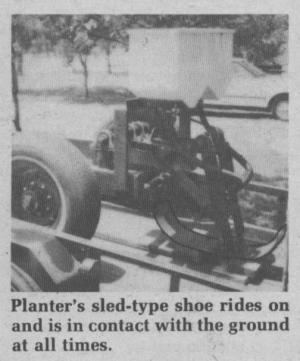No-Till Planter Works Like A Sewing Machine
 ✖  |
"It isn't necessary to rip up the ground to plant seed and fertilizer," says Arnold Topham, co-inventor along with Harry Wilson of a new no-till planter with a unique planting mechanism that injects seed and fertilizer into the ground with a "stitching" action similar to a sewing machine.
The sled-type shoe on the planter unit rides on, and is in contact with the ground at all times during planting for positive depth control of seed. The planting mechanism is adjustable on the shoe for control of depth. Spacing between plants in the row can be varied from 2 in. to 2 ft., with a change of gearing, and units can be spaced as close as 4 in. for very narrow rows.
"It's ideal for both no-till and inter-seeding into standing crops, such as planting soybeans or cotton into wheat because it rides right over heavy residue," says Topham.
Because the planter injects seed and fertilizer into the ground rather than digging a furrow, it requires much less horsepower to operate, saving both fuel and labor. "You could pull a 30-row planter of this design with a 30-hp. tractor since the sled on the planter rides over the ground with a minimum of drag," says Topham.
Savings can also be realized on seed and fertilizer because of the planter's ability to place exactly the amount of seed desired and exact amounts of fertilizer right where needed next to the seed in the row.
"This planter could potentially be used throughout the world because it can be pulled by animals as well as tractors since it's ground-driven and requires so little power to pull, says Topham.
Each row unit has alternating injectors that are "loaded" with seed and fertilizer from seed boxes by tubes from seed boxes above. The ground-driven injectors simply drop to their pre-set depth below the row unit sled and drop their seed.
The planter has several advantages over other conventional planters, according to the inventors:
1. "It's the first truly no-till planter. Absolutely no tillage is necessary. It merely pierces the ground and deposits the seed like a sewing machine pierces a piece of cloth," says Topham.
2. Lower seed and fertilizer costs because amounts of both can be more closely controlled.
3. Without the need for coulters and row openers, closer spacing is possible. Planter can plant as close as 4 in., which may be important ù especially in planting solid-seeding soybeans.
4. Labor, fuel and equipment costs can be reduced since high-horsepower tractors are not needed. Tillage trips across the field are eliminated.
5. The surface of the ground is not broken, preserving moisture.
Topham and Wilson are looking for a manufacturer to produce their planter.
For more information, contact: FARM SHOW Followup, Arnold J. Topham, P.O. Box 1013, Santa Fe, Tex. 77510 (ph 409 925-8188).

Click here to download page story appeared in.
Click here to read entire issue
No-Till Planter Works Like a Sewing Machine PLANTING EQUIPMENT Planters 9-3-23 "It isn't necessary to rip up the ground to plant seed and fertilizer," says Arnold Topham, co-inventor along with Harry Wilson of a new no-till planter with a unique planting mechanism that injects seed and fertilizer into the ground with a "stitching" action similar to a sewing machine.
The sled-type shoe on the planter unit rides on, and is in contact with the ground at all times during planting for positive depth control of seed. The planting mechanism is adjustable on the shoe for control of depth. Spacing between plants in the row can be varied from 2 in. to 2 ft., with a change of gearing, and units can be spaced as close as 4 in. for very narrow rows.
"It's ideal for both no-till and inter-seeding into standing crops, such as planting soybeans or cotton into wheat because it rides right over heavy residue," says Topham.
Because the planter injects seed and fertilizer into the ground rather than digging a furrow, it requires much less horsepower to operate, saving both fuel and labor. "You could pull a 30-row planter of this design with a 30-hp. tractor since the sled on the planter rides over the ground with a minimum of drag," says Topham.
Savings can also be realized on seed and fertilizer because of the planter's ability to place exactly the amount of seed desired and exact amounts of fertilizer right where needed next to the seed in the row.
"This planter could potentially be used throughout the world because it can be pulled by animals as well as tractors since it's ground-driven and requires so little power to pull, says Topham.
Each row unit has alternating injectors that are "loaded" with seed and fertilizer from seed boxes by tubes from seed boxes above. The ground-driven injectors simply drop to their pre-set depth below the row unit sled and drop their seed.
The planter has several advantages over other conventional planters, according to the inventors:
1. "It's the first truly no-till planter. Absolutely no tillage is necessary. It merely pierces the ground and deposits the seed like a sewing machine pierces a piece of cloth," says Topham.
2. Lower seed and fertilizer costs because amounts of both can be more closely controlled.
3. Without the need for coulters and row openers, closer spacing is possible. Planter can plant as close as 4 in., which may be important ù especially in planting solid-seeding soybeans.
4. Labor, fuel and equipment costs can be reduced since high-horsepower tractors are not needed. Tillage trips across the field are eliminated.
5. The surface of the ground is not broken, preserving moisture.
Topham and Wilson are looking for a manufacturer to produce their planter.
For more information, contact: FARM SHOW Followup, Arnold J. Topham, P.O. Box 1013, Santa Fe, Tex. 77510 (ph 409 925-8188).
To read the rest of this story, download this issue below or click
here to register with your account number.







